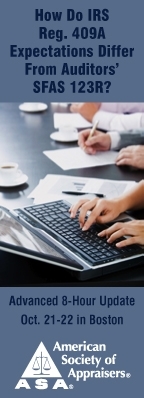
| DLOM: Under Daubert attack by the IRS The discount for lack of marketability (DLOM) is “still the most important discount in valuation,” Judge David Laro, U.S. Tax Court, said last Friday at the 2nd Annual University of San Diego School of Law Business Valuation and Tax Conference. He drew an analogy between DLOM and the GPS in your car; there are multiple routes to get to the same destination—but some of these may be more challenging and possibly more prone to mistaken assumptions, fundamental flaws, or incorrect applications. In fact, “the [Tax Court] judges and IRS want you to appreciate that some of the DLOM techniques used to ‘get there’ may or may not be acceptable under the Daubert standard,” Laro said. (Note: As always, his opinions are his own, not those of the federal judiciary or the IRS). Moreover, the same judges and IRS examiners know that “some in the BV profession have a vested, proprietary interest in some of the methods used,” the Judge added, with typically candor. “But what we in the courts want to know: Are there measurable, discernable, quantifiable differences among the DLOM techniques? We need to know that.” It’s a persistent question that BV practitioners want answered, too—and during his closing remarks, Laro also announced that he would be starting a trial this week, a case in which the IRS has challenged the taxpayer’s expert valuation, including the DLOM methods and conclusions, under Daubert. Stay tuned… Are option models the future of discounts and valuation? The Summit hallways “buzzed” with Laro’s remarks, with some practitioners wondering how the IRS could successfully challenge the same methods that its own experts and examiners use. At the same time, they agreed with Laro’s assessment that the conference sessions could “permanently change the direction of DLOM.” To make best practices more transparent, Jim Hitchner moderated a three-hour discussion by Bob Duffy, Linda Trugman, Kevin Yeanoplos, and Jay Fishman in which each panelist independently prepared—and defended--their DLOM conclusion from a Mandelbaum-based case study. The experts largely agreed that the commonly-applied DLOM analyses “have served us well and continue to do so,” Hitchner said, with somewhat more consistent emphasis on the restricted stock studies. But, “the future of valuation—not just DLOM, is option analysis,” he said, and Duffy agreed. “We started including option models in our reports—and I strongly urge you to do the same,” he said. Not only does the report become an expert’s entire direct testimony in litigation, but given the lag time between the valuation and trial—which may be years, by the time the expert takes the stand, “I guarantee you, everyone will be using the option pricing models,” Duffy said. “They will be state of the art.” Each panelist offered similar strong opinions. For instance:
Did the experts reach any consensus? Based on the same set of facts—but applying various methodologies, Duffy and Trugman concluded a 40% DLOM, Yeanoplos was at 45%, and Fishman at 55%. To learn how they all got there, read a complete report in the next (November 2009) Business Valuation Update™. More on future estate tax and restrictions on discounts “We expect Round 1 in the great estate tax battle to take place this fall/winter,” says the Washington Wire, the electronic alert from the S Corporation Association of America (SCA). “The tax goes away in 2010, and then returns in full form in 2011, giving just about everybody a reason to come to the table.” To prepare for this debate, forty-six trade associations (including the SCA) sent a letter to Congress urging it to support a permanent estate tax “fix” that includes a 35% top rate, a $5 million per spouse exclusion and up to $10 million for married couples. These are essentially the same terms that SenatorsJon Kyl (R-Ariz.) and Blanche Lincoln (D-Ark.) are currently proposing. Congress is expected to consider legislation extending certain expiring tax provisions before the end of the year, and should make an “estate tax fix” part of that bill. Porter agrees Pomeroy is dead. At the San Diego BV and Tax Summit, attorney John Porter (Baker Botts LLP, Houston), agreed that the Pomeroy Bill “hasn’t gotten much traction.” (See last week’s BVWire™.) He also believes that in 2009, “all we’ll get is a band-aid” for the 2010 estate tax, and then Congress will enact permanent legislation in 2010. He doesn’t think the debate on valuation discounts has expired, however, citing the Treasury’s Greenbook. “The devil is in the details,” he said, although the current proposals wouldn’t eliminate discounts, they would just make sure that entity restrictions are “commercially reasonable.” PCAOB urges stronger standards for valuation specialists The Public Company Accounting Oversight Board (PCAOB) has just posted Auditing Fair Value Measurements and Using the Work of a Specialist, a briefing paper to be used by its Standards Advisory Group at their meeting on October 14-15, 2009. “The staff believes that a standards-setting project to revise its existing standards on auditing fair value measurements and using the work of a specialist may be appropriate for a number of reasons,” the report begins.
The Board also urges “strengthening” an auditor’s responsibility when evaluating a specialist’s work. For example, separate guidelines should apply when the auditor engages independent versus in-house specialists, as opposed to the current single standard. “Further, the existing standards have different direction for a specialist engaged by the auditor and a specialist employed by the auditor.” Given the similarities of these situations, it might be more appropriate to apply a single standard. To read the full report, click here.
Can BV practitioners safely use the historical earnings of a business as an indicator of its future performance, given the current recession and aberrant market/credit data? Fledgling companies without any consistent history of returns will surely pose difficult problems in using management projections, according to Judge Jacqueline Silbermann, who spoke with Sharyn Maggio and Bill Morrison on Projections, Post-Judgment Events, and the Post-Bernie Madoff World at the 2nd Annual Summit on BV in Divorce in Chicago last month, co-sponsored by BVR, NACVA, and the ASA. “We’ve hit the reset button,” said Morrison. “What we need to be is very practical. We have the valuation and financial tools—we’ll still use past earnings, but even Rev. Ruling 59-60 says you just don’t average them. I think the precaution is that we’re not too pessimistic.” The session covered much more, including the pros and cons of agreeing to revisit a valuation and/or income determination in the future; using a later date to value a spouse’s business to achieve “equity,” and how to distinguish between short- and long-term economic effects. Where can you hear more? On Friday October 16th we’re rebroadcasting this session along with Current Developments in Standards of Value—Thornhill and Other War Stories, featuring Ron Seigneur, and Active vs. Passive, with Chris Mercer, Ashok Abbott, and Mark Sobel. Attendees will also receive complete presentation materials from the recast sessions. To find out more about this 2-CPE event and to register, click here. Survey: How are you developing clients during the downturn? The silver lining to the current economic cloud may be the opportunity to get caught up on a few things, including beefing up your BV business development and marketing practices. To this end, we’ve teamed with John Borrowman (Borrowman Baker LLC) to poll BV practitioners regarding the ways in which they may be maximizing the downturn so that when the economy looks up again, they’ll be ready with fresh referrals and engagement prospects. Our latest online survey is just four questions—with extra room for comments—and shouldn’t take more than four minutes. As always, responses are anonymous unless participants choose to reveal themselves. We’ll publish the results in the next ‘Wire, adding good ideas and insights to what BV practitioners everywhere might do to turn any bitter lemons of economic uncertainty into a sweeter future of firm productivity and profitability. To participate in the survey, please click here.
Attorneys still count for the vast majority of referrals for BV experts and valuation analysts. Most litigators have a fairly set “list” of trial consultants to call on, however. So, when the question came up at the September Divorce Summit regarding how a BV expert could break into the old circle, the first suggestion was to approach young lawyers and related groups at local bar associations. “Most of them have no idea what the income approach is,” said Mark Sobel. "Teach them what you do and how you do it.” Another suggestion: Offer to provide in-house training for targeted firms on how to understand financial statements and similar “BV 101” topics. You can also attend “Inns of Court” and other gatherings of judges—who are always looking for good speakers. Attorneys tend to gather wherever judges do. “Then we will see you, see that you’re good, and all of a sudden, you’re on our short list,” said Stephen Kolodny. “Marketing is mostly superficial,” added Don Schiller. "It’s nice to be taken to lunch or to go to a reception, but what’s really going to impress is if you write or lecture. Actions speak loudest.” Publishing in law magazines or professionals journals (such as the Business Valuation Update) can help expand your exposure and cement your expertise. Essentially, anything you can do to build a reputation within your legal and professional communities will help you break into the litigation Big Leagues. A complete round-up of all the lawyers’ comments, including what they expect from every BV expert, will appear in the December BVUpdate.
To ensure this email is delivered to your inbox, Copyright © 2009 by Business Valuation Resources, LLC
|
|
|



